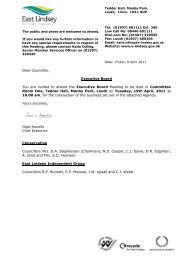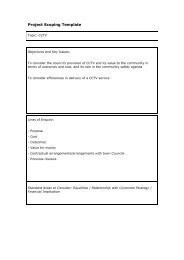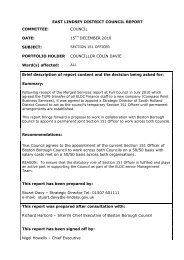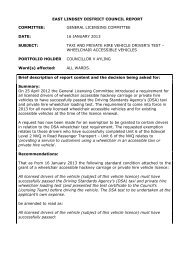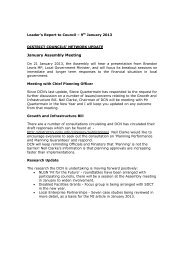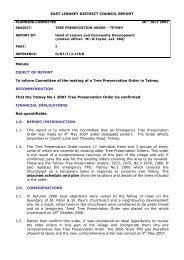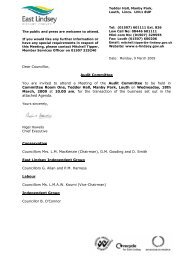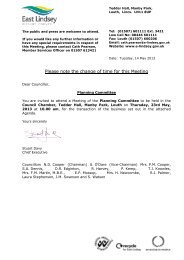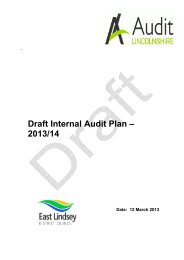N-180-00298-11, item 19. PDF 125 KB - East Lindsey District Council
N-180-00298-11, item 19. PDF 125 KB - East Lindsey District Council
N-180-00298-11, item 19. PDF 125 KB - East Lindsey District Council
Create successful ePaper yourself
Turn your PDF publications into a flip-book with our unique Google optimized e-Paper software.
[08] Full Planning Permission<br />
N/<strong>180</strong>/<strong>00298</strong>/ <strong>11</strong><br />
APPLICANT: Mr. N. Totterdell,<br />
VALID: 22/02/20<strong>11</strong> AGENT:<br />
PROPOSAL: Planning Permission - Erection of 2.no Short Wave Amateur<br />
Radio Masts and Aerials, and 4 no. 10 metre vertical poles in<br />
accordance with amended plans received by the Local Planning<br />
Authority from the applicant on 5th May 20<strong>11</strong> and 24th May<br />
20<strong>11</strong>.<br />
LOCATION: THE WHITE HOUSE, BRICKYARD LANE, THEDDLETHORPE,<br />
LINCOLNSHIRE, LN12 1NR<br />
1.0 REASONS FOR COMMITTEE CONSIDERATION<br />
1.1 The application has been called to Planning Committee by <strong>Council</strong>lor Mrs.<br />
S. Harrison for the following reasons:<br />
1. The potential impact on the adjacent national Nature Reserve Site<br />
of Scientific Interest which is an important area for migrating<br />
birds;<br />
2. Impact on the street scene in an area of the village where<br />
dwellings are very closely grouped around a single track access<br />
to the National Nature Reserve;<br />
3. Visual impact in a flat rural area which is part of the coastal<br />
grazing marsh.<br />
2.0 THE SITE AND SURROUNDINGS<br />
2.1 The site lies on the eastern edge of the settlement of Theddlethorpe.<br />
The applicants dwelling is located in the centre of the site with a 'front'<br />
garden to the south of the dwelling and a 'rear' garden to the north. The<br />
dwelling is a two storey dwelling of traditional appearance with a three<br />
bay frontage. The site lies on the western side of Brickyard Lane. The<br />
dwelling and the north of the site lies within the Coastal Conservation<br />
Area. To the north east of the site lies the Saltfleetby-Theddlethorpe<br />
Dunes Site of Special Scientific Interest (SSSI) which includes a National<br />
Nature Reserve. The site lies some 570m from the boundary with the<br />
SSSI.<br />
2.2 There are mature trees and hedging along all boundaries of the site. To<br />
the immediate south of the site is a bungalow and there are bungalows<br />
on the opposite side of Brickyard Lane to the east. The area is<br />
characterised by bungalows set in individual plots. To the north of the<br />
site are fields. Brickyard Lane leads to a small number of dwellings and<br />
the car park for the Dunes and beach.
2.3 The edge of settlement area is generally rural in character with fairly<br />
spacious plots and trees lining the road and garden edges.<br />
3.0 DESCRIPTION OF THE PROPOSAL<br />
3.1 The proposal is for the erection of 2.no Short Wave Amateur Radio Masts<br />
and Aerials, and 4 no. 10 metre vertical poles.<br />
3.2 The above consists of one 20 metre vertical pole in the southern garden<br />
of the property. This pole is 80mm at the base, gradually tapering to<br />
39mm at the top. This pole is free standing and is erected between two<br />
short steel channels that must be set in a small concrete block. The pole<br />
pivots near the bottom so can be fully raised and lowered from ground<br />
level with a winch which is set between the two channels. The applicant<br />
has advised that this pole is not required for every competition and so<br />
therefore is likely to be erected infrequently.<br />
3.3 It is proposed to erect one 24 metre mast in the northern edge of the<br />
northern garden of the property which is a lattice tower with aerials on<br />
the top. This mast can be lowered to a mid position of 7.5 metres in<br />
height when not in use and can be fully lowered to a folded position.<br />
When the mast is in this position it is 3.5 metres in height.<br />
3.4 The proposal also includes the erection of four 10 metres vertical poles in<br />
the northern garden which are arranged in a square. These poles are<br />
like fibreglass fishing rods (roach poles) with a very narrow profile.<br />
These poles measure 49mm diameter at the base and taper to 4mm in<br />
diameter at the top. The applicant has confirmed that these will not be<br />
left erected when not in use.<br />
3.5 The masts are for the use of the applicant for his hobby in amateur radio<br />
to use during radio competitions. The applicant has confirmed that a<br />
reasonable condition would require the masts to be up for no longer than<br />
48 days in a year. Many competitions are only 24 hours in duration or<br />
less. Some events are restricted to certain frequency bands and<br />
therefore only require one aerial for the duration of the event. The<br />
majority of these competitions are held at weekends.<br />
4.0 CONSULTATION<br />
4.1 Set out below are the consultation responses that have been received on<br />
this application. These responses may be summarised and full copies are<br />
available for inspection separately. Some of the comments made may<br />
not constitute material planning considerations.<br />
Publicity<br />
4.2 The application has been advertised by means of a site notice being<br />
displayed at the site and adjoining neighbours being notified.
Consultees<br />
4.3 LCC as HIGHWAYS AUTHORITY - The proposed development will not be<br />
detrimental to highway safety or traffic capacity.<br />
4.4 PARISH COUNCIL - Object - visual impact - street scene and proximity to<br />
nature reserve (SSSI).<br />
4.5 LINCOLNSHIRE TRUST FOR NATURE CONSERVATION - Thank you for<br />
consulting the Lincolnshire Wildlife Trust on this application which is<br />
within one of the grazing marsh project target areas and is close to<br />
Saltfleetby-Theddlethorpe Dunes Site of Special Scientific Interest and<br />
National Nature Reserve. We would not expect the application to have<br />
an adverse impact on the nature conservation interest of the SSSI/NNR;<br />
however, we would recommend that the views of Natural England are<br />
sought prior to determination of the application.<br />
We note that guy ropes will be used to stabilise the masts when they are<br />
erected for use. There is potential for birds to strike the guy ropes which<br />
could put the development at conflict with the aspirations of the grazing<br />
marsh project which aims to increase the numbers of birds in the area by<br />
restoration of grazing marsh. We would therefore strongly recommend<br />
that reflective markers are put on the guys so that birds would be better<br />
able to see and avoid them.<br />
4.6 NATURAL ENGLAND - Not received.<br />
Neighbours<br />
4.7 In total 223 representations have been received to the application. To<br />
date, these can be separated as follows:<br />
In favour: 98<br />
Against: <strong>11</strong>5<br />
Comments: 9<br />
Petitions against: 1<br />
The letters of support are from a range of locations but can be<br />
summarised as follows<br />
Brickyard Lane, Theddlethorpe: 7<br />
Saltfleet Road, Theddlethorpe: 7<br />
Rotten Row, Theddlethorpe: 1<br />
Sea Lane, Theddlethorpe: 1<br />
Kent Avenue, Theddlethorpe: 2<br />
Others: 80
These letters of support cover the following issues:<br />
• Do not think the aerials will be very noticeable because the site is<br />
surrounded by trees;<br />
• Amateur radio is in use during the present emergency in Japan;<br />
• Radio amateurs have just had the opportunity to show their value<br />
in the recent Operation Watermark;<br />
• It is useful to have radio amateurs who live along the UK<br />
coastline;<br />
• There are many aerials and masts en route (e.g. farms, mobile<br />
phones, CB and amateur radio aerials) between Mablethorpe and<br />
Grimsby. They are now perceived by community as part of the<br />
environment, e.g. gas terminal at Theddlethorpe;<br />
• Applicant is entitled to pursue his hobby;<br />
• Applicant is fully qualified and authorised by OFCOM;<br />
• The property is surrounded by tall trees which screen the masts<br />
and antennas from view, so no visible impact is made on the<br />
surrounding area;<br />
• Amateur radio has significant educational benefits;<br />
• Application could be made personal to applicant;<br />
• Installation will have little effect upon the surrounding properties;<br />
• Amateur radio enables contact with other radio enthusiasts<br />
around the world;<br />
• The slender nature of the antenna construction minimises the<br />
visual impact and they are totally confined within the property<br />
boundary. There are many miles of power transmission,<br />
telegraph poles and their lines traverse the highways and fields.<br />
Following installation of such amateur radio antennas, any initial<br />
minimal visual impact would quickly subside into the background;<br />
• The transmitters will not have any effect on nearby electronic<br />
apparatus, nor on health. They make no noise;<br />
• The use of retractable masts further reduce any perceived<br />
impact;<br />
• The applicant is a well-known and respected Radio Amateur;<br />
• Britain has less active Radio Amateurs, partly because most of<br />
those licensed live in urban locations with insufficient space to<br />
erect efficient antennas. I therefore strongly support anyone<br />
trying to redress this balance;<br />
• Can confirm the accuracy of the background and technical<br />
information provided;<br />
• Radio amateurs use low powers in their transmissions to other<br />
radio amateurs and need arials to be as high as possible to<br />
communicate with fellow amateurs around the world;<br />
• Similar installations have been found to have absolutely no effect<br />
on house prices or sellability at all;<br />
• The fact that the application site is the applicant's holiday home<br />
is irrelevant to the application;<br />
• Birds have to negotiate overhead telephone wires, electricity<br />
cables and other hazards every day so cannot see how these<br />
masts can contribute any significant increase in that danger;
• Letter from Estate Agent stating that in this case, the proposal<br />
would not have any detrimental effect on surrounding properties;<br />
The nearest neighbour to support the application is Homelea, Brickyard<br />
Lane:<br />
• The revised application helps reduce the impact of the aerials.<br />
The time limit of 48 days is hardly an imposition on neighbours.<br />
We can see the aerials from our house and they are not offensive<br />
in anyway.<br />
The letters of objection are also from a range of locations but can be<br />
summarised as follows:<br />
Brickyard Lane, Theddlethorpe: 13<br />
Saltfleet Road, Theddlethorpe: 22<br />
Sea Lane, Theddlethorpe: 8<br />
Station Road, Theddlethorpe: 12<br />
Rotten Row, Theddlethorpe: 3<br />
Mablethorpe Road, Theddlethorpe: 3<br />
Others: 54<br />
These letters raise the following points:<br />
• Overbearing visual impact thus harmful to living conditions;<br />
• When aerials are reduced to 6m we can still see them;<br />
• The 48 days mentioned could equate to the masts being up for a<br />
week or weekend at a time because of the difficulty in raising<br />
them;<br />
• Applicant's hobby encroaches onto properties and village around<br />
him;<br />
• Letter from estate agents stating that the siting of the masts for<br />
considerable periods of time will have a detrimental effect on<br />
both the value and saleability of adjoining properties;<br />
• Devaluing of properties;<br />
• Totally in conflict with ELDC Landscape Character Assessment;<br />
• The trees around the property do not hide the masts;<br />
• May set a precedent;<br />
• The main and attractive feature of this area from St Helen's<br />
Church to Brickyard Lane is the trees. Anything that protrudes<br />
above them would be a positive eyesore;<br />
• The applicant's website is encouraging more radio enthusiasts to<br />
the area;<br />
• Brickyard Lane enjoys an uninterrupted skyline from road to<br />
seashore and the radio masts would rise metres above the tree<br />
line;<br />
• Detrimental to appearance of countryside;<br />
• Safety concerns about masts;<br />
• Unsuitable in a residential area.
Letter of objection from The Willows, Brickyard Lane:<br />
• The applicant's remarks that the masts will have minimal visual<br />
impact is totally incorrect;<br />
• The house is the applicant's holiday home;<br />
• The masts tend to be left fully erected or half erected;<br />
• This development would have an industrial appearance,<br />
overbearing visual nature and be totally out of character with it<br />
surroundings;<br />
• It would affect tourism;<br />
• A rook has already been injured by the masts;<br />
• Concerned about how close the masts are to the boundaries,<br />
what if the guy ropes fail;<br />
• Concerned that the applicant will rent his house out to other club<br />
members;<br />
• The tower will be higher than the Angel of the North;<br />
• The trees along our boundary with the site are actually 9.5<br />
metres at the highest and 6.5 metres at the lowest, trees lose<br />
their leaves in winter.<br />
Westwood Lodge, Brickyard Lane:<br />
• Masts detract from the appearance of the lane and the<br />
surrounding vicinity;<br />
• This is supposed to be an area of outstanding beauty on the<br />
doorstep of a national nature reserve with a large amount of<br />
wildlife;<br />
• Safety issue - masts have been seen snapped and lashing in the<br />
wind;<br />
• Health risks;<br />
• Impact on neighbours property valuations and sales.<br />
Imba Matombo, Brickyard Lane:<br />
• The aerials can be seen from the road;<br />
• The White House is overlooked by neighbours;<br />
• We work from home so our telephones are important, we have<br />
had issues with people on line due to radio masts;<br />
• Will lower the chances of a sale on properties;<br />
• Why are three masts required;<br />
• The radio lines around his garden from the masts causes<br />
accidents to large flying birds;<br />
• Health risks;<br />
• We have no huge trees and the condition of the trees on the site<br />
are in thin condition and getting thinner so in future the masts<br />
will be more in view to us, these trees are not in full leaf all year;<br />
• Even when masts are lowered they are in view.
The Hollies, Brickyard Lane:<br />
• I can see the masts from my property;<br />
• Last year one of the guy ropes broke free, what if this happens<br />
when the applicant is not at the property;<br />
• This lane is well kept with tidy gardens and then you get the<br />
White House which is run down with ugly aerials/masts;<br />
• Brickyard Lane is popular with visitors;<br />
• Many species of wildlife around here.<br />
5.0 Ward Member has been made aware previously of this application<br />
as the information was provided on the Weekly List.<br />
6.0 CONSULTATION ON AMENDED PROPOSALS (proposal has been<br />
amended to the erection of two masts and four vertical poles)<br />
Consultee<br />
6.1 PARISH COUNCIL - Despite amendments, our original objections still<br />
apply.<br />
6.2 LINCOLNSHIRE TRUST FOR NATURE CONSERVATION - Our comments<br />
remain the same as those previously submitted.<br />
6.3 LCC as HIGHWAYS AUTHORITY - The proposed development will not be<br />
detrimental to highway safety or traffic capacity.<br />
6.4 NATURAL ENGLAND - Not received.<br />
7.0 RELEVANT SITE HISTORY<br />
7.1 None.
8.0 PLANNING POLICY<br />
8.1 Section 38(6) of the Planning and Compulsory Purchase act 2004<br />
requires that planning applications are determined in accordance with<br />
the Development Plan unless material considerations indicate otherwise.<br />
The Development Plan comprises the <strong>East</strong> <strong>Lindsey</strong> Local Plan<br />
Alteration 1999 (Saved Policies) and the <strong>East</strong> Midlands Regional<br />
Plan 2009. Government’s Planning Policy Statements (PPS’s) and<br />
Planning Policy Guidance Notes (PPG’s) are material considerations. The<br />
following policies are considered relevant to the consideration of this<br />
application:<br />
<strong>East</strong> <strong>Lindsey</strong> Local Plan Alteration 1999 (Saved Policies)<br />
Policy A4 - Protection of General Amenities<br />
Policy A5 - Quality and Design of Development<br />
Policy C14 - Coastal Conservation Areas - CCA1 and CCA4<br />
Policy EMP9 - Telecommunications<br />
<strong>East</strong> Midlands Regional Plan 2009<br />
Policy 26 - Protecting and Enhancing the Region's Natural and Cultural<br />
Heritage<br />
Policy 29 - Priorities for Enhancing the Region's Biodiversity<br />
Planning Policy Statements/Guidance<br />
Planning Policy Guidance Note 8 - Telecommunications<br />
9.0 OFFICER ASSESSMENT OF THE PROPOSAL<br />
Main Planning Issues<br />
9.1 The main planning issues in this case are considered to be:<br />
• Visual Impact on Landscape;<br />
• Impact on Coastal Conservation Area, SSSI and Nature<br />
Reserve;<br />
• Impact on Neighbours;<br />
• Effect on Public Health;<br />
• Interference with electrical equipment/reception.<br />
Visual Impact on Landscape<br />
9.2 Policy A5 of the <strong>East</strong> <strong>Lindsey</strong> Local Plan Alteration 1999 is concerned with<br />
the quality and design of development and states that development will<br />
only be permitted where it does not detract from the distinctive character<br />
of the locality.
9.3 Planning Policy Guidance Note 8 – telecommunications (PPG8) gives<br />
guidance on planning for telecommunications development – including<br />
radio masts and towers, antennas of all kinds, radio equipment housing,<br />
public call boxes, cabinets, poles and overhead wires. The general thrust<br />
of the document is clearly aimed at the mobile phone network but there<br />
is overlap with the application type of proposal. The only paragraph<br />
directly related to amateur radio is paragraph 80 that states:<br />
‘Applications for planning permission to install the masts often used by<br />
amateur radio operators, radio taxi firms and other private and<br />
commercial users, usually present few potential planning problems in<br />
terms of size and visual impact over a wide area. Such masts need to be<br />
high enough for technical efficiency and located as far as possible from<br />
other antennas, in order to minimise the possibility of interference.<br />
However, they will not normally be of such a scale as to have a serious<br />
impact on local amenity. Such applicants will generally have less scope<br />
for using alternative sites or for sharing sites, and masts will often need<br />
to be located on the premises’.<br />
9.4 Policy EMP9 of Local Plan Alteration 1999 is applicable and discusses<br />
telecommunications. Similar to PPG8, the policy is primarily aimed at the<br />
mobile phone network but appears to be equally applicable to this<br />
proposal. It states that ‘telecommunications development will be<br />
permitted provided it does not harm the appearance or character of the<br />
area or local amenities generally’.<br />
9.5 The site is located on the edge of Theddlethorpe. There are dwellings to<br />
the south and east and open fields to the north. Further north are the<br />
Theddlethorpe Sand Dunes and the SSSI. This edge of village location is<br />
bordered by mature trees of significant height which form a definitive<br />
edge to the settlement. During the winter months, the house is visible<br />
through the trees from further north along Brickyard Lane.<br />
9.6 The main theme of the objections received to the application centre<br />
around the visual impact of the masts and that the masts will be visible<br />
from outside the site and from nearby neighbours.<br />
9.7 The highest proposed mast is 24 metres high. This is a lattice mast with<br />
aerials on the top. This mast is on a trailer type base so is moveable but<br />
due to its size and bulk, it is unlikely the mast would be moved other<br />
than for maintenance purposes. This mast has guy ropes to keep it in<br />
place. This mast is sited in the northern most part of the garden. The<br />
20 metre vertical pole is the next tallest structure and this is to be sited<br />
in the southern garden, in front of The White House. This pole is tall and<br />
thin and does not require guy ropes. The four 10 metre vertical poles<br />
are arranged in a square to the rear of the house and do not require guy<br />
ropes.
9.8 The applicant has confirmed that he is willing to accept a condition that<br />
allows the masts to be erected for a period of 48 days only. This<br />
condition has been imposed at another site in Saltfleetby by the same<br />
applicant for <strong>11</strong> masts in an open field which was allowed on appeal in<br />
May 2010 (reference N/145/01534/09). By virtue of this condition, the<br />
masts would not be fully erected permanently. The applicant has<br />
confirmed that the 20 metre vertical pole will only be erected<br />
infrequently and the 10 metre vertical poles will not be left erected when<br />
not in use. The 24 metre mast fully retracts to a height of 3.5 and at<br />
this height, the structure would not be visually dominant and would be<br />
screened by the existing trees on the boundaries of the site. However,<br />
the applicant has stated that he would rather be required to lower the<br />
mast to its lowered position of 7.5 metres when not in use for ease of<br />
maintenance for the garden. However, if necessary he would be willing<br />
to accept a condition requiring the masts to be fully retracted to 3.5<br />
metres.<br />
9.9 In terms of assessing the visual impact on the landscape, the proposed<br />
24 metre mast is tall with aerials at the top which has the appearance of<br />
a large T.V aerial. This mast will protrude above the tree line around the<br />
garden and as a result will be visible as part of the wider landscape.<br />
There will be views of the mast from further northwards along Brickyard<br />
Lane and from the Sand Dunes. There is an existing mast in place at the<br />
rear of a property along Saltfleet Road. This is a tall, narrow structure.<br />
The mast will be seen against the backdrop of the trees lining the edge<br />
of the village and as a result will not be seen against a flat landscape<br />
backdrop. With a condition restricting the mast to be erected for only 48<br />
days, it is felt that the mast will not have an adverse impact on the<br />
character of the landscape.<br />
9.10 With regards to the 20 metre vertical pole, this tapers to 36mm at the<br />
top so the visual impact of this pole will diminish significantly with<br />
distance. The Inspector at the Saltfleetby site concluded that the<br />
slimline masts (such as the one proposed here) would be largely lost<br />
against the background of the sky. The proposal is for two high masts so<br />
this small number would not create a cluster of masts and so would not<br />
have the prominence of a large sold object such as a building (the<br />
Inspector came to this conclusion with the application for <strong>11</strong> masts at<br />
Saltfleetby).
Impact on Coastal Conservation Area, SSSI and Nature Reserve<br />
9.<strong>11</strong> The northern half of the application site is located within the Coastal<br />
Conservation Area. Policy C14 is concerned with development in these<br />
coastal areas and states that it will not be permitted unless it is essential<br />
in that location. The aim of this policy is to protect the remaining natural<br />
character and interest of the coast. This policy specifically refers to the<br />
Saltfleetby-Theddlethorpe dunes and states that it is of great ecological<br />
importance. It goes on to state that where permitted, development shall<br />
not materially harm the amenities, character or ecological balance of the<br />
area because of its siting, scale, form, appearance, materials or noise.<br />
Although the conservation area boundary runs through the centre of the<br />
site, there is no indication on the ground of the difference between the<br />
two areas. The boundary does not follow the boundary of the village<br />
which appears to be an oddity. The character of the site does not have a<br />
coastal character and I would suggest that it would be inappropriate to<br />
judge the application purely on the criteria in Policy C14.<br />
9.12 Policy 26 of the <strong>East</strong> Midlands Regional Plan 2009 is concerned with the<br />
Region's Natural and Cultural Heritage and states that damage to natural<br />
and historic assets should be avoided where and as far as possible.<br />
Policy 29 is concerned with Enhancing the Region's Biodiversity and<br />
refers the Lincolnshire Coastal Grazing Marshes as a Biodiversity<br />
Enhancement Areas.<br />
9.13 The SSSI lies to the north of the application site and a number of the<br />
objections received to the application refer to the impact of the proposal<br />
on the SSSI and birds in the area. The site does not lie within the SSSI<br />
and the nearest corner of the site is located approximately 570 metres<br />
from the nearest part of the SSSI. The 24 metre high mast is tall but<br />
will be up for only 48 days in a year. There is no evidence to suggest<br />
that these structures have an adverse impact on wildlife. The<br />
Lincolnshire Trust for Nature Conservation has been consulted and they<br />
have stated that they would not expect the application to have an<br />
adverse impact on the nature conservation interest of the SSSI/NNR.<br />
They have gone to state that there is potential for birds to strike the guy<br />
ropes which could put the development at conflict with the aspirations of<br />
the grazing marsh project which aims to increase the numbers of birds in<br />
the area by restoration of grazing marsh. They have therefore<br />
suggested that reflective markers are put on the guys so that birds<br />
would be better able to see the ropes. The applicant has agreed to the<br />
imposition of a condition requiring these reflectors to be provided on the<br />
guy ropes. Natural England have been consulted twice on the proposal<br />
but no response has been received.
9.14 The Coastal Grazing Marsh is a multi agency initiative fronted by the<br />
Lincolnshire Wildlife Trust. The Lincolnshire Coastal Grazing Marshes<br />
Partnership Project is being developed - in consultation with<br />
farmers/landowners, the local community and organisations with a<br />
vested interest - to protect, maintain and enhance the key features of<br />
the area and secure their sustainable management into the future. The<br />
overall vision of the LCGM project is to have, once again, a mosaic of<br />
grasslands, rich in wildlife, intersected by a distinctive pattern of<br />
watercourses. This will be a landscape where both arable and livestock<br />
farming thrives and communities have a high quality of life. The project<br />
has the following aims;<br />
• To reverse the decline in biodiversity in the grazing marshes;<br />
• To ensure that any landscape and land-use change enhances and<br />
protects archaeological and historical features and contributes<br />
positively to overall landscape character;<br />
• To encourage the retention and re-establishment of viable<br />
pastoral farms;<br />
• To stimulate local economic activity through the marketing of<br />
locally produced high quality products and services;<br />
• To improve the local environment for the benefit of all through<br />
enhanced access and recreation opportunities;<br />
9.15 As was relayed to the planning committee as part of the application at<br />
Saltfleetby for <strong>11</strong> masts, the grazing marsh initiative has limited weight<br />
in planning considerations. I do not consider this initiative can be used<br />
in refusing the application.<br />
Impact on Neighbours<br />
9.16 Policy A4 is concerned with impact on the amenities of neighbours and<br />
states that development will not be permitted where it would result in an<br />
adverse impact on neighbours through, for example, overbearing effect<br />
or increased noise and disturbance. A significant number of objections<br />
has been received to the proposal. The immediately adjoining neighbour<br />
to the south (The Willows) and two of the neighbours directly opposite<br />
the site (West Woodlodge and Imba Matombo) have strongly objected to<br />
the proposal. The main objection raised is that the masts are visible<br />
from their properties. Loss of view is not a material planning<br />
consideration and cannot be used to justify refusal of this application.<br />
9.17 The 24 metre mast was originally proposed in the southern garden but
has now been moved to the northernmost part of the garden to increase<br />
the distance between the mast and The Willows. As a result, the mast<br />
will be close to the neighbours opposite the site on the eastern side of<br />
Brickyard Lane. There are high mature trees along the eastern boundary<br />
of the application site which will screen the mast to a large extent.<br />
Whilst the mast is a tall structure, it is relatively narrow and of a lattice<br />
design so is not a solid structure.<br />
9.18 The 20 metre vertical pole which is the structure nearest The Willows is<br />
thin and will be lost against the backdrop of the sky. Due to its thin<br />
design it is felt that the proposed pole will not appear adversely<br />
overbearing to neighbours. The 10 metre vertical poles are again thin in<br />
their design and will be screened to a large extent by the existing trees<br />
along the boundaries of the site.<br />
Effect on Public Health<br />
9.19 The Short Wave Frequencies and the corresponding low power used by<br />
Radio Amateurs are not associated with health risks. In addition,<br />
although PPG8 primarily addresses the mobile phone networks it does<br />
advise in general terms the following:<br />
• "Health considerations and public concern can in principle be<br />
material considerations in determining applications for planning<br />
permission and prior approval. Whether such matters are<br />
material in a particular case is ultimately a matter for the courts.<br />
It is for the decision-maker (usually the LPA) to determine what<br />
weight to attach to such considerations in any particular case.<br />
• However, it is the Government’s firm view that the planning<br />
system is not the place for determining health safeguards. It<br />
remains central Government’s responsibility to decide what<br />
measures are necessary to protect public health. In the<br />
Government’s view, if a proposed mobile phone base station<br />
meets the ICNIRP guidelines for public exposure it should not be<br />
necessary for a LPA, in processing an application for planning<br />
permission or prior approval, to consider further the health<br />
aspects and concerns about them.<br />
• The Government’s acceptance of the precautionary approach<br />
recommended by the Stewart Group’s report "mobile phones and<br />
health") is limited to the specific recommendations in the Group’s<br />
report and the Government’s response to them. The report does<br />
not provide any basis for precautionary actions beyond those<br />
already proposed. In the Government’s view, LPA's should not<br />
implement their own precautionary policies e.g. by way of<br />
imposing a ban or moratorium on new telecommunications<br />
development or insisting on minimum distances between new<br />
telecommunications development and existing development."
9.20 On this basis, and given the Government’s view it would be difficult to<br />
sustain an objection on these grounds.<br />
Interference with electrical equipment/reception<br />
9.21 PPG8 advises that all users of radio equipment are required by the terms<br />
of wireless telegraphy legislation to avoid creating undue radio<br />
interference with other radio users, including domestic television sets,<br />
and their equipment must be designed to minimise it. There are also<br />
regulations made under the Wireless Telegraphy Act 1949 that set limits<br />
for unwanted radio frequency emissions from certain types of non-radio<br />
equipment, such as household appliances and some office machinery<br />
(but not computers). There are also European Regulations governing the<br />
compatibility and immunity to electromagnetic interference of electrical<br />
devices.<br />
9.22 PPG8 states: "However, significant interference can arise despite these<br />
controls. For example, the source of the interference may be a type of<br />
equipment that is outside the scope of the regulations; or there may be<br />
site-specific factors that give rise to interference, even though the<br />
legislation is complied with…. If the development has yet to take place<br />
but potential interference is causing genuine local concern, one or other<br />
of the parties may wish to seek the help of experts to assess the<br />
likelihood and degree of interference, but authorities should not seek out<br />
such problems for critical examination unnecessarily… It is unlikely that<br />
refusal of planning permission would be justified on the grounds of radio<br />
interference from a transmitter or non-radio equipment alone except in<br />
extreme cases. It may sometimes be appropriate to grant temporary<br />
planning permission to allow for a trial period of operation, but this<br />
course should not be adopted unless there is evidence of significant<br />
interference, and only as an alternative to refusal. At the end of the trial<br />
the final decision can be taken… Where applications which are turned<br />
down solely or mainly on interference grounds come to appeal, the<br />
Secretary of State will expect planning authorities to produce full details<br />
of the evidence of interference, or likely interference, and evidence that<br />
there are no reasonable remedies that would be satisfactory." Having<br />
regard for the above I have no reason to object to the proposal on<br />
grounds of electrical equipment interference.<br />
10.0 CONCLUSIONS<br />
10.1 The applicant has recognised the local objection and reduced the number<br />
of masts from three to two. The locations that have been proposed<br />
make the most of the natural screening around the application site. A<br />
significant number of both objections and letters of support have been<br />
received with opinion divided, even within the locality of the site.
10.2 As set out above, I consider that the visual effect on the landscape is not<br />
significantly adverse, particularly due to the thin nature of the poles, nor<br />
is the impact adverse on the nearby SSSI and NNR. The proposal will<br />
not have an adverse impact on neighbours due to the restriction of 48<br />
days on any approval and the slim design of the masts.<br />
10.3 I have taken into account all matters raised by the Parish <strong>Council</strong>,<br />
neighbours and all consultees but on balance I find in my view there are<br />
insufficient reasons to justify refusal and recommend approval in this<br />
case.<br />
RECOMMENDATION:<br />
Approve<br />
subject to the following conditions:<br />
1. Full Permission<br />
2 The 24 metre lattice mast shall only be in the extended position a<br />
maximum of 48 days in a calendar year. When not in use it shall be<br />
maintained in its lowered position of 7.5 metres.<br />
Reason: To protect the character of the locality in accordance with Policy<br />
A5 of the <strong>East</strong> <strong>Lindsey</strong> Local Plan Alteration 1999.<br />
3 The 20 metre vertical pole and the four 10 metre vertical poles shall be in<br />
the extended position for a maximum of 48 days in a calendar year. When<br />
not in use it shall be lowered to the ground.<br />
Reason: To protect the character of the locality in accordance with Policy<br />
A5 of the <strong>East</strong> <strong>Lindsey</strong> Local Plan Alteration 1999.<br />
4 Prior to the 24 metre lattice mast being erected, bird reflective markers<br />
shall be attached to the guy ropes and retained thereafter.<br />
Reason: To protect birds in the vicinity of the site in accordance with Policy<br />
29 of the <strong>East</strong> Midlands Regional Plan 2009.<br />
________________________________________________________________




![[12] Full Planning Permission N/113/01975/ 10 APPLICANT ...](https://img.yumpu.com/50923921/1/184x260/12-full-planning-permission-n-113-01975-10-applicant-.jpg?quality=85)
